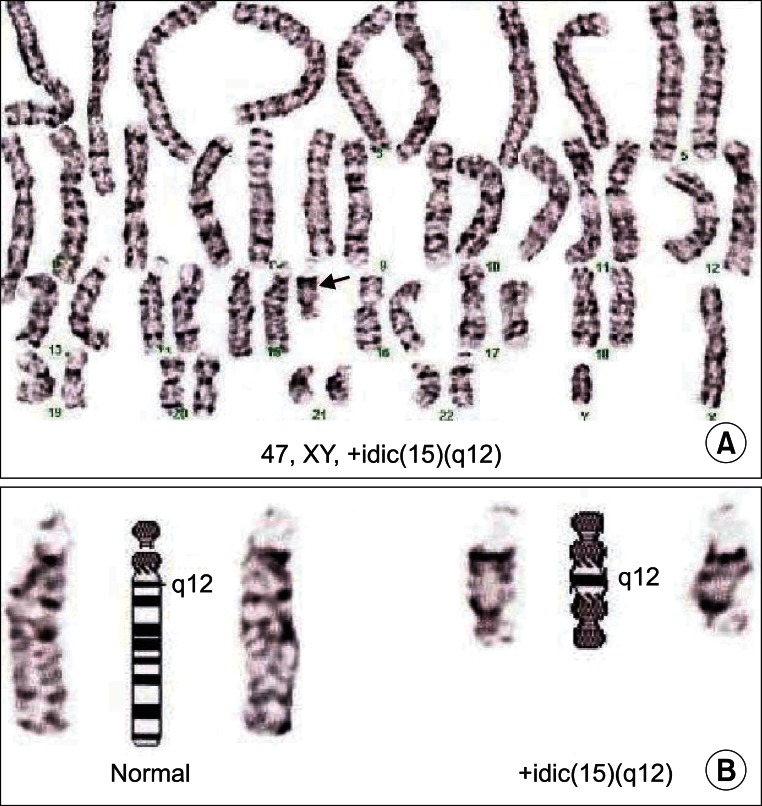Ann Rehabil Med.
2013 Apr;37(2):291-294. 10.5535/arm.2013.37.2.291.
A Nine-Month-Old Boy With Isodicentric Chromosome 15: A Case Report
- Affiliations
-
- 1Department of Rehabilitation Medicine and Research Institute of Rehabilitation Medicine, Yonsei University College of Medicine, Seoul, Korea. NYMPH-SG@yuhs.ac
- KMID: 2165785
- DOI: http://doi.org/10.5535/arm.2013.37.2.291
Abstract
- Isodicentric chromosome 15 [idic(15)] is a rare chromosomal abnormality that occurs due to inverted duplication of chromosome 15q. It is associated with many clinical findings such as early central hypotonia, developmental delay, cognitive dysfunction, autism spectrum disorders, and seizure. Delayed development is a common problem referred to pediatric rehabilitation clinics. A 9-month-old boy with delayed development was referred to our clinic for assessment and treatment. On chromosomal analysis, he was diagnosed as idic(15) syndrome with 47,XY,+idic(15)(q12) on karyotyping. Herein we describe his clinical manifestations and provide a brief review of the related literature.
MeSH Terms
Figure
Cited by 1 articles
-
Isodicentric Chromosome 15 Syndrome in a Korean Patient With Café-au-lait Spots
John Hoon Rim, Hee Jung Chung, Saeam Shin, Seo-Jin Park, Jong Rak Choi
Ann Lab Med. 2015;35(4):474-476. doi: 10.3343/alm.2015.35.4.474.
Reference
-
1. Battaglia A. The inv dup(15) or idic(15) syndrome: a clinically recognisable neurogenetic disorder. Brain Dev. 2005; 27:365–369. PMID: 16023554.
Article2. Urraca N, Davis L, Cook EH Jr, Schanen NC, Reiter LT. A single-tube quantitative high-resolution melting curve method for parent-of-origin determination of 15q duplications. Genet Test Mol Biomarkers. 2010; 14:571–576. PMID: 20642357.
Article3. Hogart A, Wu D, LaSalle JM, Schanen NC. The comorbidity of autism with the genomic disorders of chromosome 15q11.2-q13. Neurobiol Dis. 2010; 38:181–191. PMID: 18840528.
Article4. Battaglia A. The inv dup(15) or idic(15) syndrome (tetrasomy 15q). Orphanet J Rare Dis. 2008; 3:30. PMID: 19019226.5. Buoni S, Sorrentino L, Farnetani MA, Pucci L, Fois A. The syndrome of inv dup(15): clinical, electroencephalographic, and imaging findings. J Child Neurol. 2000; 15:380–385. PMID: 10868780.6. Kwasnicka-Crawford DA, Roberts W, Scherer SW. Characterization of an autism-associated segmental maternal heterodisomy of the chromosome 15q11-13 region. J Autism Dev Disord. 2007; 37:694–702. PMID: 17006779.
Article7. Robinson WP, Binkert F, Gine R, Vazquez C, Muller W, Rosenkranz W, et al. Clinical and molecular analysis of five inv dup(15) patients. Eur J Hum Genet. 1993; 1:37–50. PMID: 8069650.
- Full Text Links
- Actions
-
Cited
- CITED
-
- Close
- Share
- Similar articles
-
- A case of isodicentric chromosome 15 presented with epilepsy and developmental delay
- Partial Tetrasomy of Chromosome 22q11.1 Resulting from a Supernumerary Isodicentric Marker Chromosome in a Boy with Cat-eye Syndrome
- Isodicentric Y Chromosome Mosaic with Normal Y Chromosome in an Infertile Male Patient: A Case Report and Review of the Literatures
- Prenatal diagnosis of the isodicentric chromosome 22 associated with cat eye syndrome by multiplex ligation-dependent probe amplification
- A Case of Ring Chromosome 20 with Mental Retardation and Epilepsy



